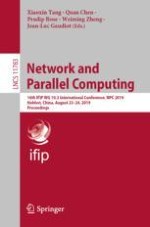2019 | Buch
Network and Parallel Computing
16th IFIP WG 10.3 International Conference, NPC 2019, Hohhot, China, August 23–24, 2019, Proceedings
herausgegeben von: Dr. Xiaoxin Tang, Quan Chen, Pradip Bose, Weiming Zheng, Jean-Luc Gaudiot
Verlag: Springer International Publishing
Buchreihe : Lecture Notes in Computer Science
